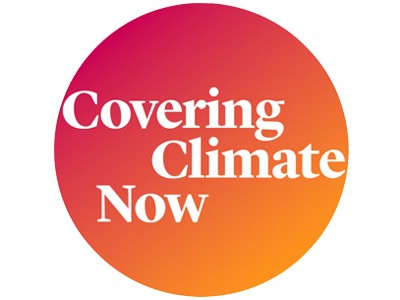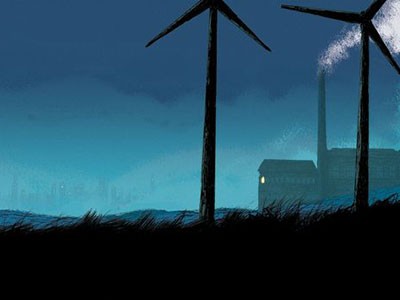
Agriculture now has much bigger yields than it did a century ago, but also requires vastly more energy input.Credit: Paulo Fridman/Bloomberg via Getty
Growth: From Microorganisms to Megacities Vaclav Smil MIT Press (2019)
In 70,000 years, Homo sapiens has grown from thousands of hunter-gatherers teetering on the brink of extinction to a global population of 7.7 billion. In Growth, Vaclav Smil explains how we have peopled the planet through our growing capacity for harvesting energy from our environment: food from plants, labour from animals and energy from fossil fuels. Civilization has developed by dominating Earth’s resources. Smil, whose research spans energy, population and environmental change, drives home the cost of growth on a finite planet. It is high: polluted land, air and water, lost wilderness and rising levels of atmospheric carbon dioxide.
Why Nature joined the Covering Climate Now initiative
He argues that most economic projections predict growth by ignoring the biophysical reality of limited resources. Economists emphasize that efficient use enables growth without pumping up energy consumption. Smil does not deny that energy efficiency has increased. For example, he details how agriculture now extracts ten times as much food energy from each parcel of land as it did a century ago. But the 10-fold increase in yield has been driven by a 90-fold boost in energetic inputs — caused by fossil-fuelled farm machinery, and electricity for irrigation and fertilizer production. When this complexity is accounted for, the story of efficiency is turned on its head: we now put more fossil-fuel energy in for each unit of food we get out.
On a crowded Earth, we mostly address this challenge by eating up more land. A 2019 report from the Intergovernmental Panel on Climate Change, called Climate Change and Land, shows that we are in danger of running out of space: humans shape more than 70% of ice-free terrain, much of it for crops and livestock. As grasslands and forests are converted to agriculture, the land is no longer available for carbon storage or biodiversity-sustaining wilderness. Human history is a story of innovation and increased efficiency, but also of relentless depletion of Earth’s resources. Is there a path to prosperity and well-being that does not rely on overconsumption?
Energy: Muscle, steam and combustion
Growth is not optimistic. There are no solutions to reconcile our species’ burgeoning consumption with a viable future. Instead, Smil focuses on simple equations that can be used to model (but rarely predict) growth and the energetic, physical and biological principles that are its foundations. He amasses examples of seemingly disparate systems that start small, enter a phase of exponential increase and then plateau.
In some cases, the trajectories tip into dramatic decline, as happened with video tapes and CDs. In others, a decline can rebound. US oil production, for instance, was in decline from 1970; with the expansion of hydraulic fracturing, or fracking, a decade ago, it rebounded. In 2018, it surpassed its 50-year-old peak. Smil shows repeatedly how beautifully fitting models have failed to predict the future.
Lurking beneath the modelling suppositions and assumptions lie some inescapable facts, he shows: the physical law of conservation of energy, the limited resources on our planet and mathematical constraints on how those resources can be converted to human use. On this foundation, we cannot continue to add 2 billion people every 25 years.
As energy use has increased, per capita gross domestic product and life spans have risen while birth rates and infant mortality have fallen. Smil admits that disentangling cause from effect and fundamental drivers from correlative happenstance is enormously difficult. However, he argues that energy is essential to the growth of our immensely complex modern civilization because it is required to do work. Every baby born, bit transmitted, material moved demands energy.
The bitter brawl over humanity’s future
Growth draws facts and figures from Smil’s other books, for a quantitative accounting of just how much energy we consume. He estimates that our hunter-gatherer forebears consumed energy per capita for food and firewood equivalent to 5–6 gigajoules per year. People in high-income countries now consume 50 times that, mainly from fossil fuels. We have turned this energy into travel that is 100 times faster than in ancestral societies; weapons that are thousands of times as destructive; and a nearly infinite increase in stored information.
This is an astounding return on our investment, but Smil is sceptical of the “techno-optimists” who envision solutions to our immense challenges coming from greater efficiency, shrinking material inputs to economic production, or information technology. He looks at technologies such as smartphones, laptop batteries and supercomputers, in which growth follows Moore’s Law — computing capacity doubles approximately every two years. In that exponential growth, he sees no hope of solving environmental crises.
As for the cost of computing, it has, in Smil’s estimate, fallen an astonishing 100 billion times since the days of vacuum tubes. But again, he sees little evidence that the ‘saving’ will save us from planetary crises, quipping that social media proves “convincingly that the volume of communication must be inversely related to its quality”. Our most spectacular technological achievements have, thus far, done little to abate our impact on the planet. Many have exacerbated it.
The environment: what’s in a word?
Smil is particularly sceptical that an artificial-intelligence (AI) singularity of exponentially self-improving machines can save us from the impacts of growth. AI has so far recapitulated trends Smil describes over human history: generating more powerful weapons and information, but little reduction in the destruction of resources. However, it seems only rational to leverage AI and computational approaches that are revolutionizing other scientific disciplines to help solve planetary-scale problems by spurring innovation and identifying economic and technological solutions. Smil devotes relatively few pages to how solar power and other types of renewable energy could grow fast enough and with a small enough footprint to be a viable path to a sustainable energy future. Yet so far, solar energy has a promising Moore-like growth trend in efficiency, while rapidly falling in price.
Growth urges us to think differently. That is desperately needed to manage the trade-offs in making renewables more efficient, improving economic incentives for fast adoption, minimizing environmental degradation and bettering lives in a swelling population. We face, after all, our most crucial singularity: a single planet whose resources have fuelled the spectacular growth of human civilization, and are now running out.

 The environment: what’s in a word?
The environment: what’s in a word?
 The bitter brawl over humanity’s future
The bitter brawl over humanity’s future
 Energy: Muscle, steam and combustion
Energy: Muscle, steam and combustion
 Energy: Burning desires
Energy: Burning desires






